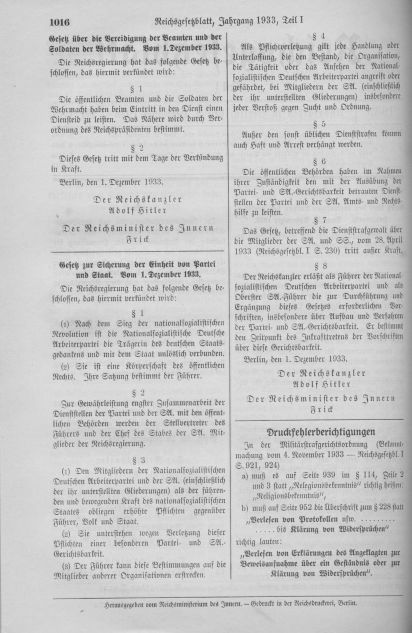Quotation from document: “(1) After the victory of the National Socialist revolution, the Nationalsozialistische Deutsche Arbeiterpartei (National Socialist German Workers’, or Nazi, Party) embodies the concept of the German State and is inseparable from the State. (2) It is a corporation under public law. Its organisation will be determined by the Führer.(...)"
Berlin, 1 December 1933
Chancellor of the Reich: Adolf Hitler
Reich Minister of the Interior: Wilhelm Frick
Explanatory note to the document
On 22 November, the prosecution presented evidence to the Nuremberg Tribunal of a criminal conspiracy to seize power. This is the Law to Safeguard the Unity of Party and State, adopted by the Reich government on 1 December 1933. A law was passed declaring the NSDAP (Nazi Party) the only political party, and making it criminal to maintain or form any other political party in Germany.
Hitler’s party purged Germany's political arena in only nine months. How was this achieved? After the elections to the Reichstag on 5 March 1933, the NSDAP, which received 44 percent of the vote, and other parties - with the exception of the SPD (Social Democrats) - formed a bloc that united two-thirds of the parliamentary seats, thus gaining a constitutional majority. This allowed the conspirators to pass the The Enabling Act, formally titled "Law to Remedy the Distress of People and Reich", which granted the German Cabinet — in effect, the Chancellor — the power to enact laws without the involvement of the Reichstag, and to override fundamental aspects of the Weimar Constitution.
The law enabled the NSDAP to force opponents either to disband forcibly (as was the case for the Social Democrats and Communists), or drive their leadership to cease political activity. Thus, the NSDAP became the only political force in Germany. Its status was enshrined in the law of 1 December 1933 - the "Law to Safeguard the Unity of Party and State".
























